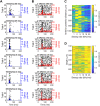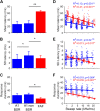The prefrontal cortex of the Mexican free-tailed bat is more selective to communication calls than primary auditory cortex
- PMID: 35975923
- PMCID: PMC9448334
- DOI: 10.1152/jn.00436.2021
The prefrontal cortex of the Mexican free-tailed bat is more selective to communication calls than primary auditory cortex
Abstract
In this study, we examined the auditory responses of a prefrontal area, the frontal auditory field (FAF), of an echolocating bat (Tadarida brasiliensis) and presented a comparative analysis of the neuronal response properties between the FAF and the primary auditory cortex (A1). We compared single-unit responses from the A1 and the FAF elicited by pure tones, downward frequency-modulated sweeps (dFMs), and species-specific vocalizations. Unlike the A1, FAFs were not frequency tuned. However, progressive increases in dFM sweep rate elicited a systematic increase of response precision, a phenomenon that does not take place in the A1. Call selectivity was higher in the FAF versus A1. We calculated the neuronal spectrotemporal receptive fields (STRFs) and spike-triggered averages (STAs) to predict responses to the communication calls and provide an explanation for the differences in call selectivity between the FAF and A1. In the A1, we found a high correlation between predicted and evoked responses. However, we did not generate reasonable STRFs in the FAF, and the prediction based on the STAs showed lower correlation coefficient than that of the A1. This suggests nonlinear response properties in the FAF that are stronger than the linear response properties in the A1. Stimulating with a call sequence increased call selectivity in the A1, but it remained unchanged in the FAF. These data are consistent with a role for the FAF in assessing distinctive acoustic features downstream of A1, similar to the role proposed for primate ventrolateral prefrontal cortex.NEW & NOTEWORTHY In this study, we examined the neuronal responses of a frontal cortical area in an echolocating bat to behaviorally relevant acoustic stimuli and compared them with those in the primary auditory cortex (A1). In contrast to the A1, neurons in the bat frontal auditory field are not frequency tuned but showed a higher selectivity for social signals such as communication calls. The results presented here indicate that the frontal auditory field may represent an additional processing center for behaviorally relevant sounds.
Keywords: bats; communication sounds; frontal auditory field; primary auditory cortex.
Conflict of interest statement
No conflicts of interest, financial or otherwise, are declared by the authors.
Figures














Similar articles
-
Representation of vocalizations in the frontal auditory field and the dorsal auditory cortex of bats.Ann N Y Acad Sci. 2025 May;1547(1):116-130. doi: 10.1111/nyas.15336. Epub 2025 Apr 8. Ann N Y Acad Sci. 2025. PMID: 40198235 Free PMC article.
-
Acoustic Context Modulates Natural Sound Discrimination in Auditory Cortex through Frequency-Specific Adaptation.J Neurosci. 2021 Dec 15;41(50):10261-10277. doi: 10.1523/JNEUROSCI.0873-21.2021. Epub 2021 Nov 8. J Neurosci. 2021. PMID: 34750226 Free PMC article.
-
Topography of sound level representation in the FM sweep selective region of the pallid bat auditory cortex.Hear Res. 2018 Sep;367:137-148. doi: 10.1016/j.heares.2018.05.017. Epub 2018 May 26. Hear Res. 2018. PMID: 29853324
-
How do auditory cortex neurons represent communication sounds?Hear Res. 2013 Nov;305:102-12. doi: 10.1016/j.heares.2013.03.011. Epub 2013 Apr 17. Hear Res. 2013. PMID: 23603138 Review.
-
Auditory cortex of bats and primates: managing species-specific calls for social communication.Front Biosci. 2007 May 1;12:4621-40. doi: 10.2741/2413. Front Biosci. 2007. PMID: 17485400 Free PMC article. Review.
Cited by
-
Neuronal activity underlying vocal production in bats.Ann N Y Acad Sci. 2025 Aug;1550(1):37-54. doi: 10.1111/nyas.15410. Epub 2025 Jul 21. Ann N Y Acad Sci. 2025. PMID: 40692182 Free PMC article. Review.
-
Representation of vocalizations in the frontal auditory field and the dorsal auditory cortex of bats.Ann N Y Acad Sci. 2025 May;1547(1):116-130. doi: 10.1111/nyas.15336. Epub 2025 Apr 8. Ann N Y Acad Sci. 2025. PMID: 40198235 Free PMC article.
References
-
- Denes PB, Pinson E. The Speech Chain: The Physics and Biology of Spoken Language (2nd ed.). Long Grove, IL: Waveland Press, 1993.
Publication types
MeSH terms
LinkOut - more resources
Full Text Sources
Miscellaneous

